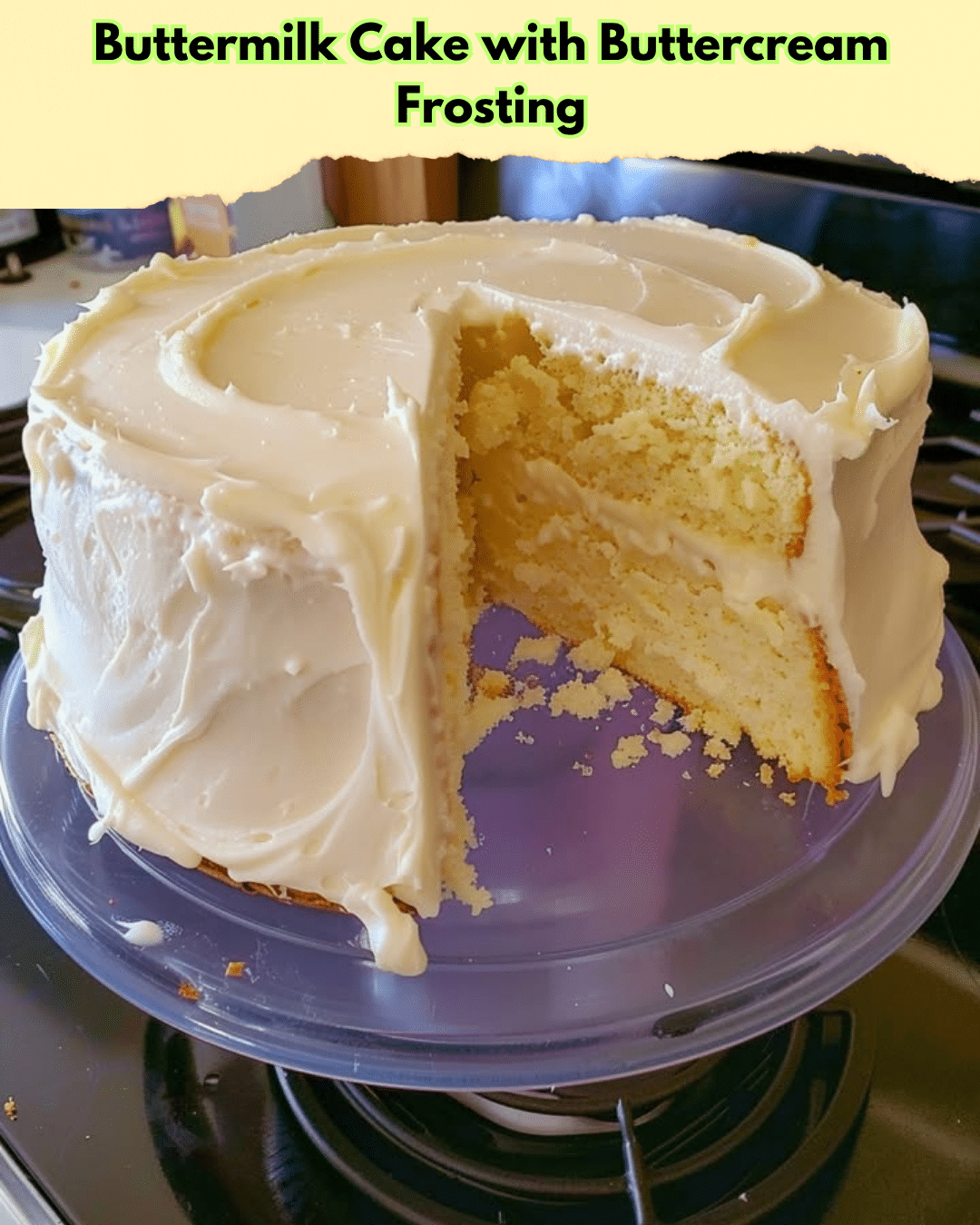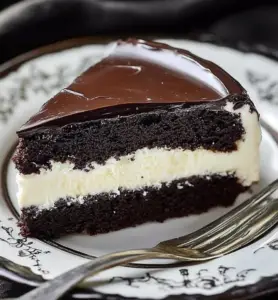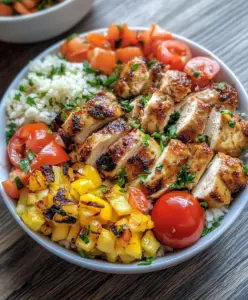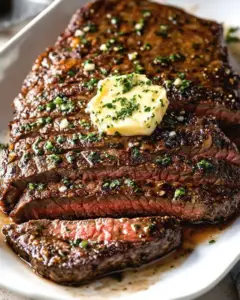Buttermilk Cake with Buttercream Frosting: A Moist and Dreamy Delight
Imagine a slice of Buttermilk Cake with Buttercream Frosting, melting in your mouth with each bite. This delightful cake features a thick, creamy layer of buttercream frosting that perfectly complements the buttermilk-infused cake. The combination of sweet and tangy creates an irresistible balance that pleases the palate. Made from simple ingredients, this cake is a surefire hit for any gathering or celebration.
Not just an everyday dessert, the Buttermilk Cake with Buttercream Frosting offers a rich flavor profile with the tanginess of buttermilk enhancing the frosting’s buttery sweetness. It’s an excellent choice for birthdays, anniversaries, or any special occasion that calls for a decadent sweet treat. With its soft texture and sweet aroma, this cake leaves a lasting impression on everyone who tries it.
Whether you are a seasoned baker or someone who enjoys baking as a hobby, this Buttermilk Cake with Buttercream Frosting is a recipe that combines robust flavors with a satisfying baking experience. Its inviting aroma wafts through the house, creating a warm and cozy atmosphere that is hard to resist.
Quick Recipe Highlights
- Flavor Profile: The cake offers a tangy sweetness from the buttermilk and buttercream, making each bite uniquely delightful.
- Texture: Expect a moist, soft cake that complements the smooth, creamy buttercream frosting perfectly.
- Aroma: A rich, buttery aroma with a hint of tanginess fills the air, inviting everyone to indulge.
- Visual Appeal: The cake boasts a beautiful, even crumb with a thick, luscious layer of frosting on top.
- Skill Level Needed: The recipe requires moderate baking skills, involving careful mixing and frosting techniques.
- Special Equipment: A good quality cake mixer, baking pans, and a palette knife for spreading the frosting smoothly.
Recipe Overview
- Difficulty Level: Though not overly complex, this recipe needs understanding of basic baking techniques to achieve the perfect texture.
- Category: This cake fits into dessert and party categories, making it ideal for celebrations where delicious, sweet indulgences are welcomed.
- Cuisine: Rooted in American culinary tradition, this cake combines classic flavors that are loved across different cultures.
- Cost: With staple ingredients like flour, sugar, and butter, this cake offers a cost-effective yet luxurious dining experience.
- Season: While suitable year-round, this cake shines during festive seasons like Christmas or Thanksgiving, adding a homemade touch to celebrations.
- Occasion: Perfect for birthdays, weddings, or a simple tea party, this cake elevates any event with its delightful taste and appearance.
Why You’ll Love This Recipe
The Buttermilk Cake with Buttercream Frosting is a taste sensation that combines tangy, creamy, and sweet all in one. The buttermilk adds a unique zing that pairs beautifully with the rich buttercream, ensuring each slice is utterly fulfilling. Its moist texture is complemented by a creamy, sumptuous frosting that melts in your mouth.
This cake is not only delicious but straightforward to prepare, making it a convenient choice for home bakers. With a total time under an hour, you can easily whip this up even on a busy day for a sweet surprise.
From a nutritional perspective, buttermilk is a low-fat dairy product while still providing calcium, and when used in moderation alongside a balanced diet, it can be an enjoyable part of your meals. This recipe allows you to indulge without too much guilt.
The cake’s versatility makes it ideal for entertaining. It can be dressed up with additional garnishes such as fresh fruits or edible flowers to fit more formal events. It’s a crowd-pleaser that’s sure to garner compliments.
When it comes to cost and accessibility, most of the ingredients are pantry staples, making this cake both wallet-friendly and easy to make from scratch without needing exotic or hard-to-find items.
Historical Background and Cultural Significance
Buttermilk, a traditional dairy product, has humble origins with a long-standing presence in culinary practices around the world. Originating as a by-product of butter-making processes, it quickly became a staple in Southern American cooking, notably used to lend moisture and tanginess to baked goods.
Its cultural relevance is profound in American baking, where it’s often used in recipes like pancakes, biscuits, and, of course, cakes. The use of buttermilk in recipes speaks volumes about its journey from farmhouse kitchens to mainstream American baking culture.
Over the years, buttermilk cake recipes have evolved, with variations popping up in different regions. Some versions incorporate fruits or nuts, while others add spices for a seasonal twist. This adaptability has allowed the cake to maintain its popularity.
Regional variations highlight the creativity in using local ingredients and adapting the basic buttermilk cake recipe to fit local tastes and ingredients, showing the recipe’s adaptability across various culinary contexts.
Ingredient Deep Dive
Buttermilk plays a pivotal role in this cake, adding moisture and a tangy flavor. Its acidic nature helps tenderize the gluten in flour, resulting in a softer texture. When selecting buttermilk, look for fresh options with a good expiration date. It should be stored in a refrigerator, away from strong odors.
Butter, a key ingredient in the frosting, provides a rich and creamy texture necessary to balance the cake’s tanginess. Opt for unsalted, high-quality butter to ensure control over the salt content and the best flavor. When storing, keep butter wrapped and refrigerated to prevent it from picking up any surrounding odors.
Flour is the structural backbone, and it’s best to use all-purpose flour for this recipe. When selecting flour, check for freshness to ensure it hasn’t absorbed moisture from the air. Storing flour in a cool, dry place extends its shelf life and keeps it free from pests.
Eggs contribute to the cake’s structure and are a binding agent for the ingredients. Use fresh, large eggs for the best results. Store eggs in their original carton in the coldest part of the fridge to maintain maximum freshness.
Common Mistakes to Avoid
- Overmixing Batter: This causes gluten to over-develop, resulting in a dense cake. Mix just until ingredients are combined.
- Incorrect Butter Temperature: For frosting, ensure your butter is softened but not melted to achieve the right creamy consistency.
- Inaccurate Measurements: Baking is a science; use the correct measuring tools for dry and wet ingredients to ensure accuracy.
- Ignoring Oven Temperature: Use an oven thermometer to verify your oven is at the correct temperature to ensure proper baking.
- Not Preparing Pans Properly: Line and grease pans to prevent the cake from sticking and ensure easy removal.
- Overbaking: Check the cake a few minutes before the suggested time, as ovens vary in temperature.
- Skipping Ingredient Sifting: Sift flour to avoid lumps and ensure a smooth batter for both the cake and frosting.
- Improper Cooling: Allow cakes to cool completely before frosting to prevent melting.
- Using Dull Knives: A sharp knife ensures clean cuts, especially important for smooth frosting presentation.
- Adding Frosting Too Soon: Let your cake cool to room temperature before frosting to avoid a melting mess.
Essential Techniques
Creaming the butter and sugar is an essential step for achieving a light, airy cake texture. This method incorporates air into the batter, which helps to leaven the cake as it bakes. To master this, ensure your butter is at room temperature and beat the sugar and butter until pale and fluffy, typically for about 3-4 minutes. Avoid over-beating as this can cause the butter to separate.
When folding in dry ingredients, a gentle hand is crucial to maintain the batter’s airiness. Use a spatula to fold, rather than stir, and make broad, circular motions to combine the wet and dry ingredients seamlessly without deflating the batter.
Temperature control is vital for successful frosting. Softened butter, not melted, allows for a smooth texture. Similarly, frosting should be applied to a fully-cooled cake to prevent it from sliding off or melting. This ensures a beautiful, even layer on top of the cake.
Proper whipping of the buttercream is crucial for a light, fluffy frosting. Beat the butter until it’s pale in color before gradually adding sugar, and continue beating until the desired consistency is reached. This process ensures a stable frosting that holds its shape when decorating.
Pro Tips for Perfect Buttermilk Cake with Buttercream Frosting
To enhance the flavor further, add a teaspoon of vanilla extract to your buttercream. It adds depth and complexity to the frosting, complementing the tangy cake.
Using parchment paper at the bottom of your cake pans can make releasing the cake much easier and ensures a smooth, professional appearance.
If possible, use fresh buttermilk for a more pronounced tanginess. Fresh buttermilk tends to have a better flavor profile compared to its long-shelf-life counterparts.
Chill the cake briefly after frosting to set the buttercream, making it easier to cut clean slices. This little step helps maintain the cake’s structure and visual appeal.
For a lighter crumb, sift dry ingredients like flour and baking powder to prevent lumps and ensure even distribution throughout the batter.
Apply a crumb coat before the final frosting layer. A thin layer of frosting seals the cake, trapping crumbs and providing a solid base for the last layer of buttercream. This technique is especially useful for creating a smooth finish.
Consider toasting your butter for a nutty depth in the cake batter or frosting, changing its profile while maintaining the original recipe’s spirit.
Variations and Adaptations
Embrace regional flavors by adding a hint of cinnamon or nutmeg into your cake batter, giving it a warm, autumnal twist that pairs beautifully with the tang of buttermilk.
For a spring adaptation, include a handful of fresh berries like raspberries or blueberries in the batter, creating pockets of fruitiness that meld with the cake’s flavors.
To make a gluten-free variant, substitute regular flour with a high-quality gluten-free blend. Ensure that your baking powder is also gluten-free to avoid any cross-contamination.
Veganizing the cake is feasible by using plant-based buttermilk (a mix of non-dairy milk and a tablespoon of vinegar) and vegan butter for the frosting, yielding a cake that’s equally as delicious.
Adding lemon or orange zest into the batter infuses a citrusy kick that brightens the cake, marrying well with the creamy buttercream.
For a health-conscious twist, replace some sugar with an apple puree or honey. This change adds natural sweetness and moisture while slightly lowering sugar content.
Elevate the presentation by using edible flowers or a sprinkle of powdered sugar over the frosting. These small touches can transform your cake’s appearance by adding visual appeal.
Serving and Presentation Guide
For a classic approach, serve each slice of cake on a simple white dish to let the cake’s color and textures stand out. Pairing with elegant dessert forks completes the look.
Consider garnishing with fresh fruit—such as strawberries or raspberries—arranged around the cake plate. This not only enhances visual appeal but also adds a burst of freshness to each bite.
Traditional accompaniments like a dollop of whipped cream or a scoop of vanilla ice cream can enhance the overall eating experience, balancing the cake’s richness.
Incorporating modern serving trays or a cake stand elevates the cake, creating a centerpiece for dessert tables at events. This simple presentation technique draws attention and admiration.
Cooling the cake before slicing is pivotal. Ensure slices are even by employing a ruler to mark portions beforehand. This practice maintains a professional appearance and equal portion sizes.
For portion control, especially at social events, consider pre-slicing the cake. This tactic allows guests to serve themselves easily and helps manage consumption quantities.
Wine and Beverage Pairing
A classic Champagne pairs impeccably with this cake, the bubbles cutting through the richness of the buttercream while complementing the cake’s tang.
A light, slightly sweet white wine, such as a Riesling or Moscato, enhances the cake’s flavor, echoing its sweetness without overpowering it.
For a non-alcoholic option, try a sparkling apple cider or a lightly sweetened iced tea. Both beverages offer refreshing contrast to the creamy cake.
If you fancy a coffee pairing, a medium roast with chocolate or nutty notes works well, balancing out the cake’s flavors and enhancing its richness.
Serving beverages chilled keeps the experience cohesive, with the cool drinks refreshing the palate and the cake providing a satisfying end.
For a tea pairing, consider a Darjeeling or Earl Grey, with their aromatic qualities harmoniously accentuating the cake’s flavor profile.
Storage and Shelf Life
After baking, store the cake in an airtight container at room temperature for up to three days to maintain freshness. This will safeguard the cake from drying out.
Refrigerating the cake extends its shelf life to about a week. Ensure the cake is well-covered to prevent it from absorbing fridge odors.
Consider storing leftover slices individually wrapped and placed in the fridge. This makes grabbing a quick slice easy without disturbing the whole cake.
Look for signs of spoilage, such as mold or an off smell. If these occur, it’s time to discard the cake to ensure safety.
If freezing, wrap the cake in plastic wrap, followed by aluminum foil, to prevent freezer burn. This method can preserve the cake for up to three months.
To serve frozen cake, allow it to thaw in the refrigerator overnight, then bring to room temperature before enjoying for the best texture and flavor.
Make Ahead Strategies
To streamline preparation, bake the cake layers a day or two ahead and freeze them. This method saves time and allows the cake to be frosted and decorated on the day of serving.
Prepare the buttercream frosting up to a week in advance, storing it in an airtight container in the fridge. Re-whip before using for optimal texture.
Plan a baking timeline beginning with gathering all ingredients and tools beforehand, ensuring a smooth and efficient process come baking day.
After baking, wrap layers tightly in plastic wrap to keep them moist until you’re ready to assemble and frost, ensuring no loss of freshness.
Use this strategy to insert fresher elements, like fruit garnishes, just before serving to maintain peak presentation and flavor.
A bonus to making ahead is the ability to address any unexpected mishaps without the pressure of a hard deadline, ensuring a professional, stress-free finish.
Scaling Instructions
When halving the recipe, reduce each ingredient proportionally and use a smaller pan, such as an 8-inch, to ensure the cake bakes evenly.
Doubling or tripling the recipe requires larger mixing bowls and possibly multiple pans. Adjust the baking time slightly, monitoring closely to avoid overcooking.
Scaling up might require adjusting oven logistics, baking in batches if all pans don’t fit comfortably in the oven without overcrowding.
Remember to adjust mixing time when you scale the recipe, particularly with buttermilk incorporation, ensuring even distribution of ingredients.
Consider storage options for larger quantities, ensuring you have enough containers or cake trays for extended preservation.
Pre-testing scaled recipes helps avoid errors, ensuring baking success, especially when preparing for large gatherings or events.
Nutritional Deep Dive
The Buttermilk Cake with Buttercream Frosting features a balanced macro breakdown, providing carbohydrates from sugars and flour, fats from butter, and protein from eggs and buttermilk.
Buttermilk stands out for its high calcium content, beneficial for bone health. While indulgent, mindful portions ensure it can be part of a balanced diet.
Moderation is key with this dessert, considering its calorie density. It’s ideal to pair it with a lighter meal to balance overall intake.
Awareness of ingredient substitutions, such as using lower-calorie sweeteners, can offer slight nutritional adjustments without sacrificing flavor.
Focus on portion size for managing weight goals. A single slice provides satisfaction without overindulgence, keeping calories in check.
Highlight the cake’s ability to fit within varied dietary plans by adjusting serving sizes or pairings with fresh fruits for a fiber boost.
Dietary Adaptations
For a gluten-free cake, replace all-purpose flour with certified gluten-free flour blends, ensuring no cross-contamination for those with sensitivities.
Dairy-free options involve using coconut oil or vegan substitutes for butter, and a combination of plant-based milk with lemon juice as a buttermilk replacement.
Craft a vegan cake by substituting eggs with a mix of yogurt and baking powder, offering the necessary leavening and moisture without animal products.
Creating a low-carb version means substituting flour with a low-carb alternative and using erythritol or stevia in place of sugar to leave out excess carbs.
To adhere to a keto diet, almond or coconut flour works well in place of regular flour, while focusing on butter and cream-based frostings that align with keto macros.
For a paleo adaptation, utilize almond butter or coconut oil, and incorporate arrowroot flour, focusing on natural sweeteners like maple syrup.
Adapting to low-FODMAP involves using gluten-free flour and lactose-free dairy substitutes, ensuring a cake that aligns with digestive sensitivities.
Troubleshooting Guide
If your cake is too dense, consider integrating more air during the creaming process or checking your baking powder’s freshness for effective leavening.
Imbalances in flavor, such as excessive sweetness, can be tempered by adding a pinch of salt or incorporating more acidic buttermilk to balance profiles.
Temperature issues can be addressed by ensuring that all ingredients are at room temperature before mixing for consistency during baking.
Equipment challenges, like low-powered mixers, can result in uneven batter; work in smaller batches to ensure thorough mixing.
Ingredient swaps, such as using margarine instead of butter, may alter texture. Opt for high-quality butter for the best results.
Timing concerns during baking are common; use a toothpick to test doneness and adjust your oven rack position to ensure even heat.
Recipe Success Stories
Feedback from readers notes the cake’s moistness and perfect balance of sweetness and tang, often referencing positive experiences at gatherings.
Adapting the base recipe with additions like chocolate chips or citrus zest has been a highlight for many, adding diverse flavors within the core structure.
Suggestions from the community include photo submissions showcasing variations with edible flowers, highlighting the cake’s adaptability to various themes.
Success stories often mention the ease of preparation and the impressive outcome, with readers sharing the recipe widely with friends and family.
Photographic tips include using natural light and neutral-colored backdrops to enhance the cake’s presentation in images, ensuring its visual appeal matches taste.
Frequently Asked Questions
Yes, you can substitute buttermilk with a mix of regular milk and lemon juice or vinegar to achieve the acidity and moisture needed for the recipe.
What if I don’t have time to make the buttercream from scratch?
Store-bought frosting can work in a pinch, though making buttercream allows for customization of sweetness and texture.
How do I prevent the cake from sticking to the pan?
Properly line and grease your baking pans, or use parchment paper to ensure easy removal without tearing the cake.
Is it possible to make this cake in advance?
The cake can be baked and stored well in advance; just ensure it’s wrapped tightly and kept at the right temperature to maintain freshness.
How can I ensure my frosting is not too sweet?
Gradually add sugar during mixing, tasting as you go, and incorporate a pinch of salt or a touch of lemon juice to balance the sweetness.
What’s the best method to slice this cake neatly?
Chill the cake briefly before slicing, and use a clean, sharp knife. Wiping the knife between cuts helps maintain clean lines.
How long can this cake be stored in the freezer?
When packed properly, it can last up to three months. Ensure it’s well-wrapped to protect against freezer burn.
How can I adapt this recipe for other dietary needs?
Explore flour substitutions for gluten-free needs or dairy alternatives for a lactose-free cake. Consider natural sweeteners to reduce sugar.
What’s a suitable non-alcoholic drink pairing?
Sparkling water with a twist of lime or lemon pairs well, offering a refreshing contrast to the cake’s richness.
How do I make the cake layers even?
Use a leveler or serrated knife, slicing off any dome that forms during baking for a smooth, even surface.
Can I add color to the frosting?
Absolutely! Gel-based food colorants work well, providing vibrant hues without altering the frosting’s consistency.
What can I do if my cake is too crumbly?
Ensure precise measurements of liquid and dry ingredients and not over-baking, which can dry the cake, leading to crumbly texture.
Additional Resources
For more delectable desserts, explore our collection of cake recipes that cater to a range of tastes, including chocolate and fruit-infused options.
Technique guides on step-by-step frosting tips help master the art of cake decoration, ensuring every cake you produce is photo-ready.
Discover more about essential cake-making ingredients with our in-depth articles on flour types, butter quality, and their impacts on baking outcomes.
Our equipment recommendations list includes the best mixers, baking pans, and storage solutions to enhance your baking endeavors.
Seasonal variations and ingredient adaptations are covered in our seasonal baking updates, offering insights into making the most of current produce.
Print
Buttermilk Cake with Buttercream Frosting
Description
A moist and tender buttermilk cake topped with a rich and creamy buttercream frosting.
Ingredients
For the Crust:
- 2 cups all-purpose flour
- 1 cup buttermilk
- 1 cup sugar
- 1/2 cup unsalted butter
- 2 large eggs
- 1 tsp vanilla extract
- 1 1/2 tsp baking powder
- 1/2 tsp baking soda
- 1/4 tsp salt
- 2 cups powdered sugar
- 1/2 cup unsalted butter, softened
- 1 tsp vanilla extract
- 2–3 tbsp heavy cream
Instructions
1. Prepare the Crust:
- Preheat the oven to 350°F (175°C) and grease a 9×13 inch cake pan.
- In a large bowl, cream together 1/2 cup butter and sugar until light and fluffy. Add eggs one at a time and mix until well combined. Stir in 1 tsp vanilla extract.
- In another bowl, whisk together flour, baking powder, baking soda, and salt. Gradually add the dry ingredients to the wet, alternating with buttermilk, until just combined. Pour batter into the prepared pan and bake for 25-30 minutes.
- For the frosting, beat 1/2 cup softened butter until creamy. Gradually add powdered sugar, and mix until smooth. Add 1 tsp vanilla extract and 2-3 tbsp heavy cream until a spreadable consistency is reached.
- Let the cake cool completely before frosting it with the buttercream.
Notes
You can customize the seasonings to taste.




